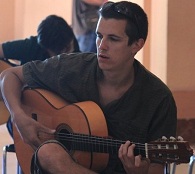Welcome to one of the most active flamenco sites on the Internet. Guests can read most posts but if you want to participate click here to register.
This site is dedicated to the memory of Paco de Lucía, Ron Mitchell, Guy Williams, Linda Elvira, Philip John Lee, Craig Eros, Ben Woods, David Serva and Tom Blackshear who went ahead of us.
We receive 12,200 visitors a month from 200 countries and 1.7 million page impressions a year. To advertise on this site please contact us.
|

|
|
[Deleted]
|
You are logged in as Guest
|
|
Users viewing this topic: none
|
|
Login  | |
|

   
guitarbuddha
Posts: 2970
Joined: Jan. 4 2007

|
 RE: table of contents-theory book (in reply to Guest) RE: table of contents-theory book (in reply to Guest)
|
|
|
Hi Kevin. There are two books which I have found to be very useful in moving towards being a whole musician and not just (just?) a classical interpreter. The first is Indirect Procedures by Pedro de Alicantara and the other is How to Improvise by Conrad Cork. The first is a pracitce methodology based on the principles of the Alexander Technique the other is a practice methodology for jazz improvisation.
In my own practice I have tried to combine the two in a way which informs flamenco.
Here is an example for Tangos ( simplest and least controversial to explain ), with static harmony.
Play one bar of compas of Ab9 and in the second bar play one note ( A open string bass ). When this is smooth and comfy and musical ....
Play one bar of compas and then in the second bar play two notes ( A on beat one and Bb on beat two )
Then three and then four notes.
Now continue to extend the scale one note at a time by adding rhythmic complexity ( this allows you to memorise the notes really easily as they emerge one at a time , it builds a really strong relationship between the chord and the scale not only in the mind but in the fingers and also since you are spending half of the time strumming compas you should be bulilding a flamenco context for the new knowledge ).
The rhythms used ( and this is a rhythmic security excercise which I learned from a DumBek drumming instructional video ) are ( phonetically )
1 2 3 4
1+2 3 4 ( quavers on beat one )
1+2+ 3 4
1+2+3+4
1+2+3+4+
then move to triplets
1and + 2 3 4....... adding triplets to each beat until
1+a2+3+a4+a
Next semiquavers and then quintuplets semuquaver triplets. When you get to G or A on the first string then start to descend ( as too many positon shifts obscure the relationship with the underlying chord grip.
After this do this with the bIImaj7+11 chord ( B flat with the optional open E and A on the third string ) go through the same process as above. Note that here you have two options (at least two common in traditional flamenco ) F major ( Bb lydian ) and D minor ( or A phrygian or Bb lydian augmented second ). Also you can use the C and the C sharp if you want.
This way of working has a real gestalt to it.
You are learning the scales(one note at a time) as they relate to the chords straight away without ever learning something that you cant use immediately. You should also be playing in great compas the whole time and you are working on the transition in hand technique between rasg and picado. You are also building rhythmic flexibility and variety into your picado.
I hope that this is useful for you.
Oh and that mode is naturally generate from the augmented ninth chord ( Jimi hendrix chord ) as such it is a blue note or an altered note ( which functions with an altered dominant ).
The bebop scale is often used in flamenco ( and most oral traditions ) but it is spelt in (Adominant) ( A,B,C#,D,E,F,G,G#). Here it helps to spell out the underlying chord (A7) when you play in quavers or semiquavers as every second note is a chord tone
A,b,C#,d,E,f,G,G#
- - - -
Sabicas used this a lot in E ( D and Dsharp in scale runs over E -phrygian tonic.)
I just looked at that last attachnment and those should definately be F naturals ( E FLAT NINTH , flat ninth is F ) and not E sharps. Also in the last chord the d has been displaced by an octave in the music (although the tab is correct ).
Wishing you continued enthusiasm and industry D.
|
|
|
|
REPORT THIS POST AS INAPPROPRIATE |
Date Jul. 2 2007 18:16:42
 |
|

   
Ricardo
Posts: 14861
Joined: Dec. 14 2004
From: Washington DC

|
 RE: table of contents-theory book (in reply to Guest) RE: table of contents-theory book (in reply to Guest)
|
|
|
Sorry I can't go and quote everything, but just some general ideas off the top of my head. For a theory book, yeah it is "intellectual" so it is fine to have your boring scales and chords charts and stuff. For flamenco "theory" you need to have a history of flamenco and glossary of terms, talk about oral tradition, etc etc.
When presenting modes, do both by parent major scale (as you did ) AND also based off of one tonic (your choice, how about A?) so the idea of modes and relations is more clear. I would avoid the "like major with raised 4th" or "like minor with b2 and b5" etc, and instead use the circle of keys, so modes are presented Lydian Ionian mixo dorian, aeolian, phrygian, locrian. Etc. Same goes for modes of harmonic and or melodic minor. Hope you get my point.
quote:
I hadn't thought of Phrygian and Bebop mixture but cool thanks.
Niether did Sabicas! LOL!
Regarding your tritone sub, I only ask Why Viejin? As if he is the only guy or best example? But you have your reasons. Hopefully you will show any dom7#11, or lydian dominant melody, in the FLAMENCO mind, is borrowing from yet another beloved Andalusian cadence, (Gm-F-Eb7-D in your Viejin example) where as the JAZZ mind thinks tritone sub. I mean I hope that is what you are going for.
Oh yeah the example of your Spanish phrygian scale is good spelling wise, but for READING I would prefer to SEE Ab-G alternating. At least in melodies where you are emphasizing those two notes so much. You COULD technically relate it to E super locrian if you want. That is modern jazz idea you see in flamenco sometimes (Nunez has ONE lick he does a lot, like you are doing FmM7 and it is F melodic minor ie E super loc in E). But only if you want to get real nerdy.
One more thing, and this is just my opinion. Most "theory" books skimp on rhythm. YOu have Chapter V where you have the toques with rhythm and harmony mixed. For me, a theory book on Flamenco, THAT Chapter, with special emphasis on ONLY rhythm, would be more than HALF the size of the entire book, and best broken into many smaller chapters. (Tempo meter subdivision swing/feel compas remates contra tiempo odd and mixed meter phrasings in compas etc ever more complex and flamenco specific headed toward the most modern trends).
But that is just me. Maybe I should make my own book. Yeah, forget everything I just said actually!    
Ricardo
|
|
|
|
REPORT THIS POST AS INAPPROPRIATE |
Date Jul. 3 2007 22:19:02
 |
|
 New Messages New Messages |
 No New Messages No New Messages |
 Hot Topic w/ New Messages Hot Topic w/ New Messages |
 Hot Topic w/o New Messages Hot Topic w/o New Messages |
 Locked w/ New Messages Locked w/ New Messages |
 Locked w/o New Messages Locked w/o New Messages |
|
 Post New Thread
Post New Thread
 Reply to Message
Reply to Message
 Post New Poll
Post New Poll
 Submit Vote
Submit Vote
 Delete My Own Post
Delete My Own Post
 Delete My Own Thread
Delete My Own Thread
 Rate Posts
Rate Posts
|
|
|
Forum Software powered by ASP Playground Advanced Edition 2.0.5
Copyright © 2000 - 2003 ASPPlayground.NET |
0.078125 secs.
|


 Printable Version
Printable Version










 New Messages
New Messages No New Messages
No New Messages Hot Topic w/ New Messages
Hot Topic w/ New Messages Hot Topic w/o New Messages
Hot Topic w/o New Messages Locked w/ New Messages
Locked w/ New Messages Locked w/o New Messages
Locked w/o New Messages Post New Thread
Post New Thread